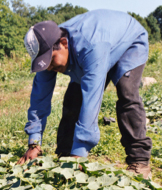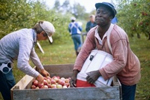
Muscle Strain Due To Stooping
Introduction – epidemiology
Prevalence – One of the most difficult ergonomic challenges in agriculture is the prolonged stooping required in ground crop work, both for weeding and harvesting. Many other common ergonomic exposures likely to produce musculoskeletal strain in agriculture (e.g., lifting, repetitive movements), can be more easily mitigated with changes in work practices, tools, or equipment. One of the largest studies of migrant worker occupational health to date (McCurdy et al., 2003), found muscle strain reported by 30% of respondents, and the back was the most frequent strain location (18%). The California sample in this study was largely ground crop workers. Fathallah and colleagues (2008), estimate that one-third to one-half of all migrant and seasonal workers in California (134,000 – 200,000) are at high risk for low back strain as a result of stoop work.
Mechanism of injury – Fathallah and colleagues (2008) have reviewed the literature on the mechanism of low back injury. From their work, the following key points help explain how low back strain results from stooped postures in agriculture:
- Passive viscoelastic connective tissues (intervertebral discs, ligaments, tendons, fascia, and passive connective muscle tissue) provide support and stability of the lumbar spine in stooped postures.
- Flexion of the spine (sustained or in cycles), reduces the stiffness of the passive spinal tissues.
- Since support and stability in fully flexed postures is provided by passive tissues, even slight reduction in passive tissue stiffness due to prolonged loading can greatly reduce spinal stability and increase susceptibility to injury.
- In addition, spinal flexion also results in reductions in intraspinal fluid, which reduces the load bearing capability of the nucleus, the transfer of loading to the more sensitive exterior fibers of the annulus, increasing the likelihood of injury.
Prevention research – because stoop work in agriculture is so common throughout the U.S. and the world, a number of interventions have been explored that might reduce the impacts on the back. Stools, carts, harnesses, hoes and other equipment have been evaluated and continue to be developed. To date, the only intervention that appears to reduce low-back pain symptoms is brief (5-minute) rest breaks each hour of working (Faucett et al., 2007). Fortunately, short work breaks are a simple, inexpensive intervention that can be recommended to workers, or preferably to their employers.
Summarized from:
- Fathallah FA. Musculoskeletal disorders in labor-intensive agriculture. Appl Ergon. 2010 Oct;41(6):738-43. Epub 2010 Apr 15.
- Fathallah FA, Miller BJ, Miles JA. Low back disorders in agriculture and the role of stooped work: scope, potential interventions, and research needs. J Agric Saf Health. 2008 Apr;14(2):221-45.
- Faucett J, Meyers J, Miles J, Janowitz I, Fathallah F. Rest break interventions in stoop labor tasks. Appl Ergon. 2007 Mar;38(2):219-26. Epub 2006 Apr 17.
 Low Back Pain
Low Back Pain